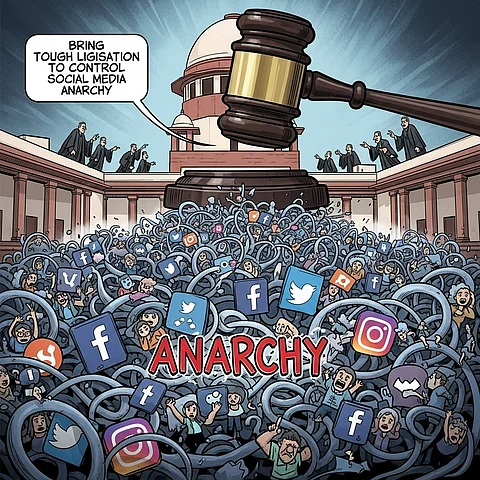

In today's digital age, social media has significantly transformed the landscape of information exchange, not just in India but globally. Platforms like YouTube, Instagram, WhatsApp, X (formerly Twitter), and Facebook enable the rapid dissemination of information, offering users unprecedented access to news and opinions. However, this speed comes with a critical drawback. It is potential to shape public opinion, often with the spread of illegal and misleading information. This rapid spread of misinformation has damaging repercussions, tarnishing the reputations of individuals, organizations, political parties, and even entire nations.
Google Removed 11000 YouTube Channels
In the second quarter of this year, Google removed 11,000 YouTube channels due to allegations of disseminating disinformation. Notably, 7,700 of these channels were associated with China. According to Google, these Chinese channels were accused of promoting propaganda, particularly aimed at audiences in India. The content shared by these channels often supported the ruling party of the People’s Republic of China, praised President Xi Jinping, and criticized US foreign policy. This action by Google underscores the ongoing efforts to combat state-sponsored disinformation campaigns on major digital platforms. The large number of Chinese channels involved indicates a strategic attempt by China to influence global narratives, especially in India, through online propaganda. Google's decision highlights the crucial role that tech giants play in safeguarding the integrity of information and thwarting foreign influence operations that could affect geopolitical dynamics and public perception.
Factors Influence Value of Views & Shares
A worrying aspect is the increasing number of individuals, often lacking necessary insight, who are turning to social media as their primary source of income. Compounding this issue is the absence of sufficient oversight or regulatory frameworks for social media platforms, which operate free from the constraints that govern traditional print and electronic media.
Influencers generate income from a variety of sources, including YouTube advertisements, brand endorsements, merchandise sales, Patron support, public appearances, and more. Many leading influencers boast a worldwide following and increasing their earnings. Their income is often impacted by the geographical location of their audience, as CPM rates differ between countries, rather than solely depending on their country of origin. On the economic front, social media has become a lucrative platform, with individuals earning significant incomes through viral content. Unfortunately, some of these platforms are getting incomes from spreading defamatory content, while others allegedly receiving substantial funding from abroad, particularly those inciting social conflicts.
Top Influencers Are From US & India
Due to massive populations and high internet penetration, the US and India have the largest number of top influencers. Nevertheless, based on general trends and publicly accessible estimates for 2024-2025, we can identify several notable figures and the factors that affect their income. Some of the popular and high income influencers are - MrBeast (USA - YouTube), Cristiano Ronaldo (Portugal - Instagram), Lionel Messi (Argentina - Instagram), Kylie Jenner (USA - Instagram), Selena Gomez (USA - Instagram), Dwayne "The Rock" Johnson (USA - Instagram), PewDiePie (Japan/Sweden - YouTube). American stunt master Mr. Beast earns $85 million a year from YouTube. He is the highest earner in the world through social media. Indian cricketer Virat Kohli earns $1.38 million, or about Rs 12 crore, annually from Instagram. All the top influencers are using their talent to make a good income through social media. However, new entrants into the field, hoping to earn a lot of money, are trying to get the most views with manipulative content and fake activities, which is bad for society.
Spread of False Narratives
While social media can sometimes expose truths and catalyze justice, as evidenced by public outrage over the inhumane incident in Manipur last year, it also facilitates the rapid spread of false information. Moreover, troubling trends have emerged, including the dissemination of dubious narratives regarding military operations like Operation Sindhur, as well as conspiracy theories surrounding Prime Minister Narendra Modi’s statements. Some social media accounts have even spread misinformation favouring adversarial nations like Pakistan. Such unchecked narratives pose a significant threat to national unity and identity.
SC’s New Push to Regulate Social Media
The impact of rampant misinformation extends beyond individual reputations, exacerbating caste and religious tensions within society. Recently, the Supreme Court of India has called on the central government to establish a regulatory body to monitor and control divisive speech on social media and recommended forming a committee to scrutinize the information circulating online. Although the union government is drafting guidelines, effective implementation remains elusive.
There is a pressing need for a regulatory framework for social media, akin to that for traditional media. The government must set clear guidelines and delineate the responsibilities of those managing these platforms. Without such measures, misinformation is likely to proliferate, fostering societal divisions and leaving individuals uncertain about what is true and what is false. The pervasive influence of social media underscores the urgent need for action to ensure that truth prevails over falsehoods, safeguarding the fabric of our society from escalating internal conflicts.
